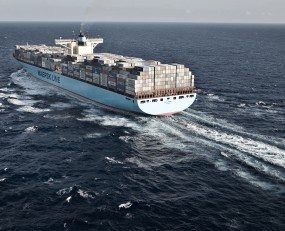
Whilst the separation of the two parts of A.P. Møller – Mærsk A/S is hardly a surprise it is still slightly shocking that the largest shipping-line in the world, and a company once so apparently invincible, is having to contort in such a manner in order to survive.
It is also not surprising that the company articulates the move as shedding its oil business to become a group focussed on “transport, logistics and ports businesses”. This will include not only the container shipping operation, Mærsk Line, the container terminal company APMT but also the freight forwarder Damco, which had been the target of much speculation. Mærsk was founded as a shipping business and it would have been extraordinary if the Mc-Kinney-Mærsk family would have withdrawn from what has been its family business for over a century.
It has been fairly clear since the loss of its Qatar production license in June that Mærsk’s oil operations have had a question-mark over them. The fall in the oil price has stressed even the largest oil and gas producers, so one of the modest size of Mærsk was always going to face strategic choices. Rumours suggest that the new oil and gas company may purchase or merge with other companies and certainly Mærsk’s statement yesterday hinted at such a possibility. Its comment about the limited investment prospects in the ‘Off-shore Supply’ division illustrated the distress of the oil and gas sector.
Yet this strategic refocus will not solve the core problem of poor profitability in container shipping and much of the rest of the new logistics focussed portfolio. The statement that “APM Terminals will focus on cost and utilization and increase its focus on operational excellence to enhance returns” suggests that even in what was a rapidly growing business the attention will shift to sustaining profit margins. The changing direction of the group also hinted that Damco will apparently collaborate with Mærsk Line to “deliver new innovative customer solutions supported by significant investments into digital technology”. It is unclear what the specifics of this are, however it implies a new relationship between the forwarder and the shipping line.
A.P. Møller – Mærsk also strongly implied how its core container shipping business would respond to the changing and crisis ridden container market. Whilst stating that “Mærsk Line will grow market share organically and through acquisitions” may appear bland, the fact that it even mentions acquisitions is worth noting. Whilst Mærsk has often been somewhat unsuccessful at buying companies in the past, in today’s market it may be back on the table. The problem is how to do this whilst sustaining the new concentration on returns on investment.
The new corporate portfolio at A.P. Møller – Mærsk in the end must achieve one core objective, that is better returns on assets through a leading position in the container shipping market. To do this will not be easy, but the objective is now central to the whole of Mærsk.
Source: Transport Intelligence, September 23, 2016
Author: Thomas Cullen